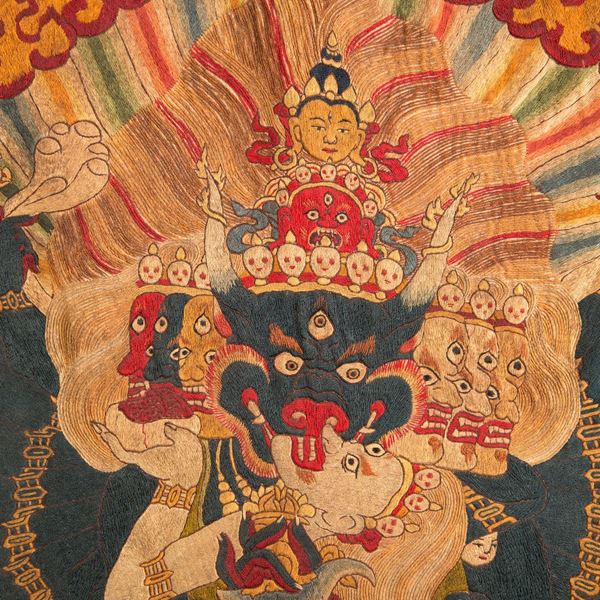RARE EMBROIDERED THANGKA DEPICTING VAJRABHAIRAVA WITH CONSORT VAJRAVETALI, Tibet - Nepal, 18th / 19th century
It retains its silk frame and depicts Vajrabhairava with his consort Vajravetali. He is represented with nine heads: the main one in the form of a fierce buffalo with three eyes and horns, seven additional demonic heads in human form, while the ninth crowning the others depicts the benign, golden-skinned Manjushri. With his thirty-four arms he wields an array of weapons, while his sixteen legs trample birds, dogs and Hindu deities. The act he performs is to embrace his consort Vajravetali, a sexual union of yab-yum, the masculine and feminine principle or compassion (karuṇā) and wisdom (prajñā), alluding to a dualistic totality. For this extraordinary embroidery, the artist has used fine silk thread to achieve brilliant colour gradations and underlying horsehair to create three-dimensional effects.
Provenance: from a distinguished private Italian collection.
Catalogue notes:
The irate Vajrabhairava is a yidam, a deity presiding over the great yoga tantras of Tibetan Buddhism, and is the most popular tantric manifestation of Manjushri.
In this form Vajrabhairava is sometimes referred to as Yamantaka, i.e. the victor over death, a deity who ends samsara, the cycle of rebirth, and consequently offers a path to nirvana. In this true form, Manjushri reveals the awesome and terrifying nature of enlightenment.
Embroidered thangka are very rare, see the example with the same subject but from the 15th century in the collection of The Metropolitan Museum of Art in New York, object number 1993.15.
十八/十九世纪 西藏/尼泊尔唐卡












